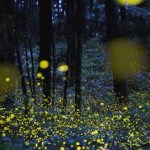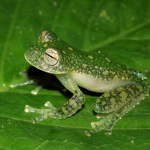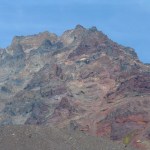peru
You'll recall that a while back, Greenpeace activists entered a restricted zone in Peru, where the Nasca Lines are preserved, and messed with that important archaeological site. I wrote about it here.
At the time, the individuals who had carried out this unthinkable act managed to drift off into obscurity, and Greenpeace seemed unwilling to provide Peruvian authorities with their names.
Now, they have done so. Partially.
From Bloomberg Businessweek:
Greenpeace has provided Peruvian authorities with the identities of the four foreign activists principally responsible for vandalizing the…
Jeff Cremer, a nature photographer, discovered mysterious tiny glow worms (~0.5 inches long) in Peru near the Tambopata Research Center a couple of years ago. Scientists still have not identified the species of these glow "worms", but suspect they are actually click beetle larvae. Entomologists Aaron Pomerantz, Mike Bentley, and Geoff Gallice from the University of Florida decided to go to Peru to investigate the worms. Here is what they found:
Researchers in Peru have discovered four new species of tiny so-called "glass frogs" (family: Centrolenidae).
Centrolene charapita: with the yellow splotches on its back, this species was aptly named after little yellow chili peppers. Their hindlegs also had fleshy little zigzag-like protuberances whose purpose is unknown.
Figure 4 from Twomey et al. Zootaxa, 2014.
Cochranella guayasamini: This species is mostly green with yellow encircling its eyes. Interestingly, the tadpoles begin as a reddish pink color. Since they live in streambeds that are low in oxygen, this coloration…
Image of seals from www.fanpop.com/clubs/the-animal-kingdom/images/14060694/title/seal-wall…
Paleogeneticist Dr. Johannes Krause (University of Tübingen, Germany) and colleagues were interested in the origin of tuberculosis (TB) in the Americas. Since strains of TB found in the Americas are related to strains found in Europe, prior theories held that Spaniards may have introduced it to the Americas while colonizing South America. The problem with those theories is that pre-Columbian skeletal remains showed signs of TB much earlier.
Dr. Krause was quoted in Scientific American, “…
A fly landing in the ear of a tourist visiting Peru turns out to be more than just annoying. The screwworm fly had sufficient time to lay eggs that hatched flesh-eating maggots in her ear canal.
Warning: the video may be disturbing to some viewers
As strange as this sounds, it is not that uncommon
Fortunately the screwworm fly has been effectively eradicated in the United States since the 1960's by releasing sterile male flies resulting in fewer and fewer offspring. This work was conducted by the USDA as you can imagine how this fly would decimate livestock.
In stark contrast to the hard liberalism of TW is one of the worst pieces of woolly-thinking soft liberalism (well, actually the Green Party, of which I'm a member and supporter, if you care. It is from their mag). And yet somehow it seems all too typical.
Life in the Peruvian Andes is hard... blah blah... Recently, these communities have experienced the worst winter to hit Peru in nearly 50 years with temperatures plummeting to a deadly minus 24ºC Oh dear. Well, clearly they could do with a bit of warming, then, no? Or are we really obliged to pretend that all climate change is necessarily…
The northern Chilean and southern Peruvian Andes are full of volcanoes that look stunning - I mean, jaw-dropping details of volcanism litter the landscape. The reason for this is two fold: (1) there is an awful lot of volcanism in the northern Chilean/southern Peruvian Andes (as known as the Central Volcanic Zone) - and has been that way for over 10 million years and (2) it has also been very, very dry in the area (most of which is known as the Altiplano-Puna Plateau) for at least a few millions years as well - it is the home of the Atacama Desert! So, this means you get lots of volcanic…
A nice short piece on "The Prehistory of Stress" by Matt Ford at Ars Technica (newly designed site worth checking out).
I have heard people say, on multiple occasions, that they think stress is a modern, Western phenomenon. While the psychological phenomenon known as stress has only had a formal name for just over 80 years, knowing when it was first suffered by our ancestors is a daunting task. Was life really better in the past? Is stress an entirely modern phenomenon?
Using modern forensic technology and a decidedly modern understanding of biochemistry, researchers from The…
There have been a number of articles floating around the popular press for the last week that I thought I would touch on briefly ... always fun to decipher the real news from the hype.
Active fumaroles on Datun Mountain in Taipei.
An article out of the Taipei Times suggests that the city of Taipei in Taiwan is in great peril from Datun Mountain/volcano. The volcano, which was previously thought to have erupted ~200,000 years ago is now thought to have erupted only 5,000 years ago. That 195,000 years really does make a difference in terms of worrying about potential future eruptions, but…
tags: Manu, Peru, travel, birding, eco-tourism, vaccinations, Kolibri Expeditions
I was contacted by Gunnar Engblom (Kolibri Expeditions), whom I've been casually acquainted with online for years, asking me if I'd like to be the "official blogger" for a birding trip to Peru. Yeow, would I?!? This unexpected offer surprised me, to say the least, but it didn't take too long for excitement to set in after I realized this was a serious offer: I would get to observe and photograph wild parrots!
Unfortunately, I have recently been preoccupied with several seemingly insurmountable tasks, including…
All the volcano news that is fit to print, all thanks to the USGS/Smithsonian GVP!
Highlights (not include Manda Hararo, Kilauea and Mayon) include
San Miguel in El Salvador has been experiencing increased seismicity. The last time the volcano erupted was in 2002.
A pilot spotted a ~10,000 foot / 3 km ash plume emanating from Anak Krakatau in Indonesia.
Another ash plume, this time at Ubinas, Peru, was spotted by pilots rising to ~6.7-9.1 km / 20-30,000 feet.
Explosions were heard from Suwanose-jima in Japan, but no associated ash plumes were spotted.
It sounds like a lava dome has been…
Your weekly dose of volcano news brought you by the Smithsonian Institute GVP and the USGS.
This week's highlights (not counting Sarychev Peak and Turrialba) include:
13,000 foot / 4 km ash plumes from Rinjani in Indonesia. This is part of the continuing eruption there.
The alert level was lowered at Galeras, Colombia to "Orange" after intense eruptions last week.
The current lava dome at Redoubt is 1 km long, 460 m wide, and 200 m high according to the latest images from the Alaskan volcano.
18,000-23,000 foot / 4.8-7.7 km ash plumes from Shiveluch in Kamchatka, along with thermal anomalies…
You'll have to excuse the curtness of this post. An bad hop in softball will do that to you.
Here's some news:
Mt. Dempo in Indonesia
Xinhua offers some nice pictures of the current activity going on at the summit crater at Nyiragongo in the Congo. Note the partially-crusted-over lava lake in the first shot. The Red Cross is updating the evacuation and mitigation plans for the area as the volcano shows increased activity.
The alert level at Mt. Dempo in Indonesia was raised to the second highest level. There has been ash fall (as far as 10 km from the vent) and volcanic gas emissions. The…
A week's worth of volcano news in one sitting, thanks to the USGS and Smithsonian Inst.'s Global Volcanism Program.
Thanks again, Sally Kuhn Sennert for putting it together!
This week's highlights include:
Small ash column spotted at Manam, Papua New Guinea. We talked about Manam not too long ago.
More details of the ongoing submarine eruption at West Mata in the Mariana Islands.
The lava dome continues to grow on Redoubt, Alaska with no real collapse yet.
Pilots spotted small (2.1 km / 7,000 foot) steam/ash plumes at Suwanosejima, Japan.
5-6 km / 18-25,000 foot ash plumes were produced by…
El Misti in Peru, as seen from Arequipa.
As I like to remind people concerning volcanic hazards, an ounce of prevention is worth a pound of the cure. This is not to imply we can prevent volcanic hazards from affecting us, but rather that proper mitigation in the form of monitoring, planning, education and practice can save countless lives (and dollars) when a volcano erupts. Officials in Peru seem to believe this, as they recently ran for practice evacuations for residents around El Misti, in the southern part of the country. Jersy Mariño from the Instituto Geológico, Minero y…
Maria Reiche was an archaeologist and mathematician who worked on the Nazca lines in Peru. Originally, she worked with Paul Kosok, who discovered the remarkable drawings, and starting in the mid 1940s, Reiche mapped in the drawings. She believed that the lines represented a calendar and a sort of observatory. She is probably single handedly responsible for the preservation of these important archaeological features.
She died in Lima in 1998.
Several crackpots have suggested that the Nazca lines, since they can only be taken in visually from a height achievable only with flying machines…
There are, indeed, other volcanoes erupting right now worldwide other than Chaiten. Of course, when you have an eruption like Chaiten going on, it is hard to pay attention to other eruptions.
Ubinas, Peru
Ubinas, in Peru, has been having intermittent ash eruptions for the past few months, depositing ash on the surround communities. Apparently these eruptions have been causing some respiratory ailments to the local Peruvians due to the ash & volcanic gases. Ubinas is one of the most active volcanoes in Peru. This picture shows Ubinas erupting in 2006, as captured from the International…




